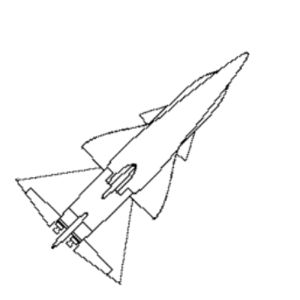
Home - Search - Browse - Alphabetic Index: 0- 1- 2- 3- 4- 5- 6- 7- 8- 9
A- B- C- D- E- F- G- H- I- J- K- L- M- N- O- P- Q- R- S- T- U- V- W- X- Y- Z
Shuttle R134G
 Rockwell 1971 Rockwell 1971 shuttle proposal 160 pixels Credit: © Mark Wade |
Status: Study 1970. Payload: 20,500 kg (45,100 lb). Thrust: 25,564.10 kN (5,747,038 lbf). Gross mass: 2,000,000 kg (4,400,000 lb). Height: 98.00 m (321.00 ft). Diameter: 10.37 m (34.02 ft). Apogee: 185 km (114 mi).
The North American Phase B design was prepared under contract NAS9-10960 and reflected the final revised shuttle specification of 11 November 1970. The low cross-range orbiter used configuration NAR-130-G, and had a payload of 20,500 kg and a cross range of 516 km. The structure was of Al-4V titanium alloy, and protected by a radiative thermal protection system, and a columbium nose cap. Haynes-188 tiles were used on the forward fuselage, and Inconel panels on the aft fuselage. The shuttle could accommodate four crew and ten passengers, plus payload in a 4.57 m x 18.3 m bay just behind the crew cabin. Two aluminum liquid oxygen tanks were located below the forward payload bay.
4 JTF22B-2 turbofan engines (versions of the F100 fighter engine without the afterburner), used liquid hydrogen as fuel. The orbiter would reenter at a 60-degree nose-up attitude, and had a hypersonic L/D of 0.56. North American had concern about the shock interaction on the forward part of the wing for the Faget configuration, but NASA insisted that their wind tunnel tests at Mach 10 showed the problem was only a bit worse than a delta configuration. In subsonic flight the orbiter would have an 8.2:1 lift to drag and a 250 kph landing speed. Study showed that for every 1% shortfall in main engine specific impulse, there would be an 11% reduction in payload. Expected temperatures were 1650 deg C on the leading edge, and 760 deg C on the belly.
The B8G booster was designed by Convair and had a 'V' tail. In three minutes it would take the orbiter to 70,000 m and 11,000 kph, hitting a peak of 4G's. After separation of the orbiter, it would spend 10 minutes in a hypersonic braking glide, finally starting its air breathing engines at subsonic speed when 500 km downrange and 6700 m altitude. The subsonic cruise back to base would take 90 minutes. The booster had a 0.5 hypersonic L/D, and 6.7 L/D subsonic. It was equipped with 12 x 188,000 kgf SSME engines.
In the Phase B Final Report these shuttle designs was modified. The North American Rockwell/Convair team's booster was now the B9U configuration, 82 m long with a 43.6 m wingspan. Propulsion had grown to 12 x 249,000 kgf main engines, and 12 x JF22A-4 air breathing engines powered by JP-4 fuel.
In late 1969 the USAF had indicated a preference for all-aluminum structures in the shuttle due to a titanium shortage. This requirement forced a move to non-metallic thermal protection systems, which at the time it was thought would weigh 15% less but cost 300% more. Thermal protection shingles for a titanium structure would weigh 2300 to 4500 kg less, but an aluminum structure would weight about 1800 kg more - meaning there was no essential weight difference between the two approaches. Therefore at the aluminum structure was accepted as a specification requirement. In retrospect it could hardly have been necessary to apply this requirement on a project where only a few flight vehicles were be built. It made the shuttle much more vulnerable to any breach of heat shield integrity and would lead to the death of the Columbia crew 35 years later. The resulting need for a non-metallic thermal protection system would also have enormous cost and schedule consequences for the actual program.
LEO Payload: 20,500 kg (45,100 lb) to a 185 km orbit at 28.50 degrees.
Family: orbital launch vehicle, Winged. Country: USA. Agency: North American, Convair.
Back to top of page
Home - Search - Browse - Alphabetic Index: 0- 1- 2- 3- 4- 5- 6- 7- 8- 9
A- B- C- D- E- F- G- H- I- J- K- L- M- N- O- P- Q- R- S- T- U- V- W- X- Y- Z
© 1997-2019 Mark Wade - Contact
© / Conditions for Use